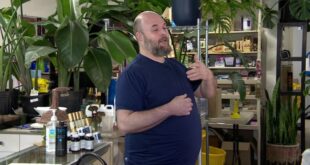Border agents called key players in efforts to mitigate Canada's toxic drug crisis

The Canadian border agency is in a constant game of cat-and-mouse with criminal organizations that are trying to import dangerous narcotics as well as the ingredients for fentanyl — sometimes through "creative" means, says a senior border official.
In an interview with CBC's The House as part of the program's ongoing coverage of the toxic drug crisis, Aaron McCrorie, vice-president of intelligence and enforcement at the Canada Border Services Agency (CBSA), said officers have seen a wide variety of "innovative" methods to smuggle drugs.
"We see shipments being concealed in in machine parts. Being dissolved in liquids and being shipped as maple syrup, for example. Being hidden in baking tools," McCrorie told host Catherine Cullen.
"It's an ever-evolving game where we're constantly looking at new and different tactics to smuggle drugs into the country or out of the country."

Featured VideoSmugglers are using more creative and sophisticated ways to get illicit drugs across the border, and this week The House gets a rare demonstration from CBSA sniffer dog Loki on how he detects narcotics at the border. Then we hear from Aaron McCrorie, VP of Intelligence and Enforcement at the Canada Border Services Agency, about the ways in which drugs are being concealed and why precursor chemicals — the ingredients used to make drugs — are becoming a bigger problem.
An average of 21 people die every day in Canada from the toxic drug crisis. Fentanyl, a powerful synthetic opioid, is involved in many of those deaths.
But a significant portion of the fentanyl in Canada — or the substances used to manufacture them — have their origins overseas.
According to the CBSA, 496 grams of fentanyl was seized in the first half of this year, along with nearly 31,000 kilograms of other narcotics, drugs and chemicals over the first two quarters of 2023.
Two milligrams of fentanyl is considered a lethal dose.
Among the tools used by CBSA in its work to stop the influx of drugs are dog sniffer teams, like the one visited by The House at the Lansdowne border crossing in eastern Ontario.
Speaking with Cullen, McCrorie reiterated what The House heard from the RCMP earlier this month: that criminal organizations in Canada produce fentanyl both for domestic consumption and to sell abroad.
Key markets for Canadian fentanyl include the United States, Australia, New Zealand and Japan, law enforcement officials say.
CBSA is charged with intercepting the shipments, whether they're being imported or exported.
"The challenge for us is they're constantly changing," McCrorie said.
"We're constantly on the lookout for new and different ways of concealment, sharing that information with their frontline staff and folks like our dog team so that they can successfully interdict drug shipments coming into the country."
More and more precursor chemical shipments
A trend seen by CBSA officials in 2023 is an increasing number of shipments that contain the key ingredients of fentanyl, rather than the completed drug.
"We're seeing a decrease in the amount of fentanyl coming into the country, but we're seeing increases in the amount of precursors coming into the country," McCrorie said.
Most of the precursor chemicals for fentanyl are imported to Canada from China, either directly or transhipped via the United States or South American countries, law enforcement says.
For years, Canada has had a collaboration with China to combat flow of illegal fentanyl and other opioids. The United States recently agreed to restart its own co-operation on the issue following a meeting between U.S. President Joe Biden and China's President Xi Jinping.
The federal government also recently moved to regulate some fentanyl precursors.
McCrorie said the challenge of precursors is that they sometimes have legitimate purposes, making it difficult for regulations to keep up, or the chemical composition might change quickly.
"It's a constant battle to on our part to identify new precursors coming into the country and then working with our partners — like in Health Canada, for example — to get those precursors listed so we can stop them coming in."
McCrorie said that Canada's ability to stop drugs at the border is an important part of the overall fight against the toxic drug crisis — but it's only one part.
"It's not just about interdicting the drugs but it's also about harm reduction. It's also about preventing people starting to use these drugs in the first place," he said.
"I've got colleagues all across town, all across the country, all around the world who are tackling this. Every interdiction, even if it's one dose, we're saving one life. We just got to keep doing that, keep making a difference and turn the tide."
ABOUT THE AUTHOR
Journalist
Christian Paas-Lang covers federal politics for CBC News in Ottawa as an associate producer with The House and a digital writer with CBC Politics. You can reach him at christian.paas-lang@cbc.ca.
With files from Catherine Cullen and Kristen Everson

Add some “good” to your morning and evening.
A variety of newsletters you'll love, delivered straight to you.
*****
Credit belongs to : www.cbc.ca
 MaharlikaNews | Canada Leading Online Filipino Newspaper Portal The No. 1 most engaged information website for Filipino – Canadian in Canada. MaharlikaNews.com received almost a quarter a million visitors in 2020.
MaharlikaNews | Canada Leading Online Filipino Newspaper Portal The No. 1 most engaged information website for Filipino – Canadian in Canada. MaharlikaNews.com received almost a quarter a million visitors in 2020.






